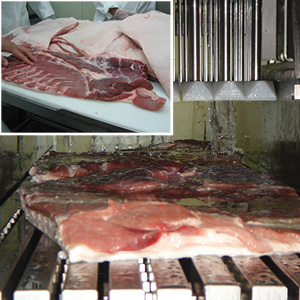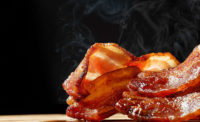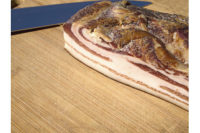
|
| Photo courtesy of Jeff Sindelar, Univ. of Wisconsin-Madison |
One of the biggest impacts on bacon quality comes down to fat. Bacon has changed significantly from years past because of the amount of fat currently in bacon and the quality of that fat.
“We’ve seen a trend for leaner hogs, and since bacon is typically 50 percent lean and 50 percent fat, give or take, whenever you change that fat component, you change a lot of things downstream, from the raw materials in manufacturing to injection levels, thermo processing characteristics and slice yields,” says Jeff Sindelar, assistant professor and extension meat specialist at the University of Wisconsin in Madison.
Pigs have been made leaner through genetics and husbandry practices, resulting in a pig today that is much different than a pig from 50 years ago, says Roger Mandigo, professor emeritus of the animal science department for the University of Nebraska-Lincoln.
“Genetics, over the years, has put a lot of stress and pressure on trying to produce a leaner pig,” he says. “That has happened, and they have gotten rid of certain deficiencies in those pigs.”
The quality of pork fat — specifically the use of ingredients that can affect the fatty acid composition or the amounts of saturated versus unsaturated fat in a pig — has been another major change affecting bacon processing, Sindelar says. The use of dry distiller grains, a byproduct of the ethanol industry, is the main reason. Dry distiller grains have grown as live hog rations due to being a cheaper feedstock.
“The downside of that is, if it’s used at too high of levels you can and do change the fatty acid profile, which results in a higher amount of unsaturated fatty acids that results in softer, greasier belly fat,” Sindelar explains. Mandigo agrees that nutrition has a great effect on pigs today.
“We have pigs that are raised on high-corn, high-grain diets, and then we have hogs that are being fed other byproducts, which are nutritionally acceptable to the pig, but the firmness and the hardness of the fat in the bellies changes depending on how you feed the animal,” he explains. “The pig is a single-stomach animal just like the human, so the way you ingest your fats is the way your body deposits those fats, generally speaking.
“In the pork market today, we’ve got some softer bellies that are a little harder to process, and bacon is one of those areas that can be quite difficult,” he adds.
The market weight at which the pig is harvested also continues to grow due to financial efficiencies.
“There was a time when maybe the typical market hog weight was about 230 or 240, and today it’s quite a bit higher because it takes a lot of feed and energy to produce that pig,” Mandigo says. “The pig is pretty efficient at it though.”
As the live weight of the pig that is harvested continues to get larger, all the pieces of the pig also become larger.
“You are getting bellies that are bigger, heavier, which now changes the dimension of a slice of bacon,” Mandigo says.
Processing improvements
Shortening bacon manufacturing has driven many of the innovations in the processing of the product.
“If you look back in time, bacon processing has not been a fast process by any means,” Sindelar says. “It’s typically been an emersion or a dry curing process followed by a resting state or time for equilibrium of the curing ingredients and followed by slow thermal processing. Twelve to 14 hours plus has not been uncommon to thermal process bacon, and, of course, the slicing and packaging steps after that. Today, we are seeing more refinement in those areas, faster processing times and almost everybody uses some type of injection.”
In regard to injection, equipment is now on the market that is able to isolate and improve injection percentages and improve uniformity of injection.
“There are injectors that are being manufactured now that are able to distribute different amounts of brine in different parts of the belly,” Sindelar says. “If you look at a belly left to right like a bacon slice, from side to side typically there are variations in the thickness of those bellies. By being able to focus injection percentages on those different sides or different thicknesses of the belly, you are able to improve uniformity and improve processing time because then you don’t have to spend as much time doing a tumbling or a resting state, which is typically used to improve uniformity of injection ingredients.”
The industry is also seeing shorter thermal processing times — sometimes down to 4.5 to 5 hours of thermal processing — followed by more rapid chilling or tempering for slicing, Sindelar says. Bacon processing also is using more uniform high-speed slicing. Advancements in slicing equipment have helped increased the amount of the entire belly that can be sliced so that less ends and less waste has to be used for other purposes or lower value products, Sindelar says.
A lot of energy is spent on getting the bacon slab the right temperature before it is sliced, so it slices better and more efficiently with more high-quality slices and less scrap, Mandigo adds.
“That efficiency and that success is really tied to getting the belly just right, so that when it presses and when it slices, it gives the maximum marketable product,” he says.
Many bacon slicers and presses used today have been around for a long time. The difference now, Mandigo says, is that most of the equipment is computer driven.
Uniformity remains one of the greatest concerns for many bacon processors.
Bacon processors deal “with a raw material that has a tremendous amount of variation and try to result in a product that is uniform for a consumer,” Sindelar says. “You’ve got bellies that are every shape and size. They are obviously broken down by weight, but a 12-pound belly can come in dozens of different shapes and sizes, even though the weights are essentially the same. Because of that, you’ve got a lot of widths and lengths and thicknesses and a lot of those types of things that you are trying to make as uniform finished product as you possibly can.”
Bacon outlook
With lower-fat bacon alternatives and low-sodium bacon offerings entering the market, bacon processors continue to bring innovation to retail and foodservice.
“Bacon is an interesting category of products,” Sindelar says. “I have never seen consumers shy away from bacon because of the amount of fat that is in a bacon slice with the bacon that we are producing today.”
Fat is essential to achieve bacon’s desirable flavor, frying performance and texture along with consumer acceptability of bacon, he adds.
“When we get to too lean of a bacon, we end up with product that has a tendency to be more crumbly and will shatter more,” Sindelar explains. “It is typically less desirable by consumers, so I think there is definitely a balance that we have to maintain. We’ve gone through times where bellies have been extremely fat and then bellies became extremely lean, and I think we’re starting to slowly rebound where we’re starting to raise hogs that have a little bit more fat and subsequently have a little bit higher fat contents in the bellies and, of course, the bacon.”
The lean meat in combination with the fat makes bacon the unique product it is when consumers taste it.
“I’m not saying that everyone is a fanatic bacon eater,” Mandigo says. “There are some who don’t eat bacon, obviously, but there is a big demand for that flavor because beef bacon, for example, is still a product that people want to have more of even though pork bacon is the massive amount of the market.”
While pork bacon is still the market leader, bacon processors are also making bacon out of animals including turkey, duck and chicken — and the sky is the limit, Mandigo says.
“Basically bacon is lean muscle interspersed in a certain amount of body fat from that particular animal,” he explains. “If the animal has other unique properties, they either come across into the bacon or otherwise hopefully you can mask them or change them if it’s something that you don’t like.”
Bacon also is an interesting food because typically it is a higher-sodium product.
“When you manufacture bacon, most of the salt ends up in the lean portion,” Sindelar explains. “So when you are manufacturing bacon and you are adding 2 percent or 2.5 percent salt, you are really concentrating that salt. It becomes a little easier to reduce salt in bacon because you are starting with a fairly high-salt product and the function of that in bacon is almost primarily for flavor. You can reduce salt in bacon as long as you are not affecting consumer acceptance where the product is too bland.”
Bacon processors have been lowering the salt content on a continual basis, Mandigo says.
“You probably can never have it completely salt-free because salt is part of the flavor profile,” he says. “There are a lot of people with salt interests wanting less and less salt. Today, bacon doesn’t have nearly as much salt in it as it might have had 20, 50 or 100 years ago.”
Although thick-cut and flavored bacons are still enticing to consumers, in recent years center-cut bacon has become more popular with consumers. Bacon processor are taking off part of the left and part of the right from the slice to produce a center portion. This creates a higher quality portion because the bacon has more uniform thickness throughout the center portion of a slice and less fat, Sindelar says.
“Because typically the fat-to-lean ratio varies from left to right on a bacon slice, you are essentially removing the greatest part of the fat-to-lean variation, resulting in a very uniform bacon slice that has a very uniform fat-to-lean ratio, so it would be considered a premium bacon slice,” he explains.
On the financial side, bacon processors always are concerned with how much bacon they can get out of the belly from which they started.
“Everybody wants to get another pound more, but by the same token, processors are more aware that consumers are pretty discriminating and they want a unique flavor or they want a unique size or they want a shape,” Mandigo says.
Because of processors’ desire to generate the most value they can for the belly, the market is seeing all kinds of bacon byproducts, he says. For example, bacon bits used to be a novelty item — sometimes not even made out of meat — but with processing innovations and new packaging concepts, bacon bits have become a very convenient product for consumers, Mandigo explains. Bacon-processing equipment also is being refined and improved to make it more efficient and accurate to produce less scrap or mistakes of little pieces that can’t be sliced and made into a package of bacon, he says.
“Remember there are all those little pieces that can’t make it into a full slice,” Mandigo explains. “Finding a better market for each of those components of that belly becomes a real challenge. People are always looking for a new and a unique way to find something that someone really wants.”
Today, in some cases, bacon is drawing in more value than ham and even more value than pork loin.
“If you look at the dollar value, that dollar value says you better have a real strategy on what you are going to do to those bellies and for the bacon that you can make from them,” Mandigo says.





Report Abusive Comment